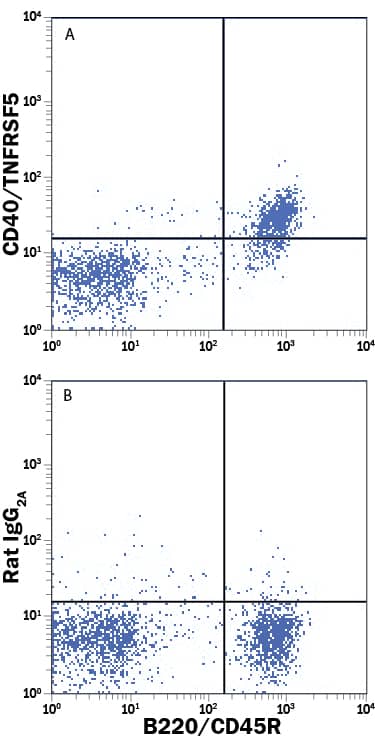Mouse CD40/TNFRSF5 Fluorescein-conjugated Antibody
R&D Systems, part of Bio-Techne | Catalog # FAB440F


Key Product Details
Species Reactivity
Applications
Label
Antibody Source
Product Specifications
Immunogen
Extracellular domain
Specificity
Clonality
Host
Isotype
Scientific Data Images for Mouse CD40/TNFRSF5 Fluorescein-conjugated Antibody
Detection of CD40/TNFRSF5 in Mouse Splenocytes by Flow Cytometry.
Mouse splenocytes were stained with Rat Anti-Mouse B220/CD45R APC-conjugated Monoclonal Antibody (Catalog # FAB1217A) and either (A) Rat Anti-Mouse CD40/TNFRSF5 Fluorescein-conjugated Monoclonal Antibody (Catalog # FAB440F) or (B) Rat IgG2AFluorescein Isotype Control (Catalog # IC006F). View our protocol for Staining Membrane-associated Proteins.Applications for Mouse CD40/TNFRSF5 Fluorescein-conjugated Antibody
Flow Cytometry
Sample: Mouse splenocytes
Formulation, Preparation, and Storage
Purification
Formulation
Shipping
Stability & Storage
Background: CD40/TNFRSF5
CD40 is a type I transmembrane glycoprotein belonging to the TNF receptor superfamily. The mature mCD40 consists of a 172 amino acid (aa) extracellular domain, a 22 aa transmembrane region and a 90 aa cytoplasmic domain. CD40 is expressed on B cells, follicular dendritic cells, dendritic cells, activated monocytes, macrophages, endothelial cells, vascular smooth muscle cells and several tumor cell lines. The extracellular domain has the cysteine-rich repeat regions, which are characteristic for many of the receptors of the TNF superfamily. Interaction of CD40 with its ligand, CD40L, leads to the aggregation of CD40 molecules, which in turn interact with cytoplasmic components to initiate signaling pathways. Early studies on the CD40-CD40L system revealed its role in humoral immunity. Interaction between CD40L on T cells and CD40 on B cells stimulated B cell proliferation and provided the signal for immunoglobulin isotype switching. Mutations in the CD40L gene, which resulted in a CD40L molecule unable to interact with CD40, are responsible for the hyper-IgM syndrome. Cross-linking of CD40 with antibodies or by binding to CD40L produces cell type-specific responses which include costimulation and induction of proliferation, induction of cytokine production, rescue from apoptosis, and upregulation of adhesion molecules. Some of the early events of intracellular signaling by the CD40-CD40L system include the association of the CD40 with TRAFs and the activation of various kinases.
Alternate Names
Gene Symbol
Additional CD40/TNFRSF5 Products
Product Documents for Mouse CD40/TNFRSF5 Fluorescein-conjugated Antibody
Product Specific Notices for Mouse CD40/TNFRSF5 Fluorescein-conjugated Antibody
For research use only